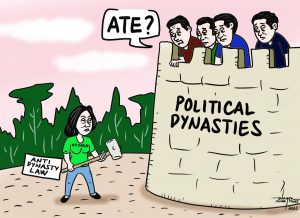Here we are again. We mean Davao City is back to the noise on flood and how to prevent it from happening. Yes, both the local and national governments are starting to increase the decibel of their talks about the flooding problem and what projects are undergoing implementation and to be implemented to avoid the flood from inundating the low-lying areas of the city.
Early this week several areas in the downtown section of Davao City were submerged in flood water. As usual, the worst hit is the area on the C. P. Garcia Diversion Road specifically at the location of La Verna Subdivision. The water on the highway was so deep that several motor vehicles conked out and those inside have to race for their lives out. The sunken vehicles that include a pick-up, once retrieved by the owners will be having engines close to total wreck.
So, expect happy days for local automotive repair shops and vehicle dealers to be here again. Thanks to the floods in the city.
But frankly what we and so many other Davaoenos cannot understand is the failure of either the local or national government to identify and implement flood control projects that are far from palliatives.
These two government entities have been talking and introducing big ticket projects with primary focus on improving the drainage system in the area. Every time the anti-flooding projects are started so much noise is made claiming that finally these would end the suffering of the people in the areas leading to Panacan going farther north of the city.
But no sooner the noise decibel dies down so do the news updating the public on the projects also wane. So, what is left are the people scrambling for the latest on this and anti-flooding projects if only to be ready when the next flood comes.
Of course it is a given that in terms of damage to properties, it is always the residents of houses at La Verna Subdivision who will suffer the most. However, not far behind in terms of the value of the damage done every time flood hits La Verna and that stretch of the Diversion highway, the city’s and those neighboring towns going up north, is its economy.
Consider this scenario: A flood on the La Verna stretch of the highway that does not recede for even just a single day can stall the flow of a number of articles of commerce from Davao City going north, or vice versa. What would that mean to the economy of both the city and the towns or cities in the north?
Who shall the people lay their blame on for this predicament of Davao City? Most likely they will point to the destroyed environment. They will look up at the more accepted rationalization nowadays – climate change – one broad terminology so easy to understand but so complex to reconcile with its many attributed causes.
Unfortunately however, every discerning citizen knows that the government – both local and national – is actually contributing to a large extent the speed with which the dreaded climate change is coming our way.
How? Simply put, the government and the people authorized to craft policies that are supposed to govern the utilization of nature’s God-given gifts make every regulation “flexible” according to their common personal interests.
Say, why do our policy makers in Davao City allow the conversion of large agricultural plane into massive residential subdivisions thereby allowing developers to cut down coconut trees, rubber or cacao and durian plants in an area in Barangay Ula, Tugbok district?
Why does Davao City have a zoning plan that has certain areas not available for this and that business endeavor ending up being “spot-zoned” or “re-zoned” by the City Council to give way to certain favored businesses and businessmen? Why are some areas considered protected ended up utilized by big businesses for their own greedy motive?
Yes, even hills just within the peripheries of Davao City’s downtown are allowed by our policymakers to be flattened if only to provide more space for subdivision developers to sell.
And look at the slopes of Matina Shrine Hills and the sides of the mountain along the Magtuod barangay road. Trees are felled down to open spaces for high-end subdivisions overlooking the city’s main business district (MBD) and the majestic Island Garden City of Samal and the blue waters of the Davao Gulf.
Yet, the local and national government planners are far from prepared in dealing with the impact of what they claim as development, one of which and the more serious of all, the worsening and getting to be more disastrous floods in the once calamity-free city.
Shall they wait for the floods to become a deluge before thinking of one real anti-flooding project to implement?
Pray, no Davaoeno would want to have their Davao City included in the list of “sinking” areas in the country. It has no more trees to get the lumber needed to build a “Noah’s Ark” type of rescue boat to ensure their survival as a people.



